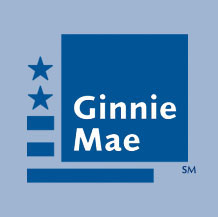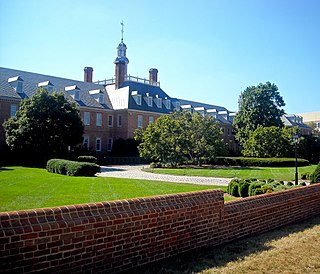Related Research Articles

The Government National Mortgage Association (GNMA), or Ginnie Mae, is a government-owned corporation of the United States Federal Government within the Department of Housing and Urban Development (HUD). It was founded in 1968 and works to expand affordable housing by guaranteeing housing loans (mortgages) thereby lowering financing costs such as interest rates for those loans. It does that through guaranteeing to investors the on-time payment of mortgage-backed securities (MBS) even if homeowners default on the underlying mortgages and the homes are foreclosed upon.

The Federal National Mortgage Association (FNMA), commonly known as Fannie Mae, is a United States government-sponsored enterprise (GSE) and, since 1968, a publicly traded company. Founded in 1938 during the Great Depression as part of the New Deal, the corporation's purpose is to expand the secondary mortgage market by securitizing mortgage loans in the form of mortgage-backed securities (MBS), allowing lenders to reinvest their assets into more lending and in effect increasing the number of lenders in the mortgage market by reducing the reliance on locally based savings and loan associations. Its brother organization is the Federal Home Loan Mortgage Corporation (FHLMC), better known as Freddie Mac.

Franklin Delano Raines, also known as Frank Raines, is an American business executive. He is the former chairman and chief executive officer of the Federal National Mortgage Association, commonly known as Fannie Mae, who served as White House budget director under President Bill Clinton. His role leading Fannie Mae has come under scrutiny. He has been called one of the "25 People to Blame for the Financial Crisis" according to Time magazine.

The Federal Home Loan Mortgage Corporation (FHLMC), commonly known as Freddie Mac, is an American publicly traded, government-sponsored enterprise (GSE), headquartered in Tysons, Virginia. The FHLMC was created in 1970 to expand the secondary market for mortgages in the US. Along with its sister organization, the Federal National Mortgage Association, Freddie Mac buys mortgages, pools them, and sells them as a mortgage-backed security (MBS) to private investors on the open market. This secondary mortgage market increases the supply of money available for mortgage lending and increases the money available for new home purchases. The name "Freddie Mac" is a variant of the FHLMC initialism of the company's full name that was adopted officially for ease of identification.
The Federal Agricultural Mortgage Corporation, also known as Farmer Mac, is a stockholder-owned, publicly traded company that was chartered by the United States federal government in 1988 to serve as a secondary market in agricultural loans such as mortgages for agricultural real estate and rural housing. The company purchases loans from agricultural lenders, and sells instruments backed by those loans. The company also works with the United States Department of Agriculture. It is based in Washington, D.C.

A mortgage-backed security (MBS) is a type of asset-backed security which is secured by a mortgage or collection of mortgages. The mortgages are aggregated and sold to a group of individuals that securitizes, or packages, the loans together into a security that investors can buy. Bonds securitizing mortgages are usually treated as a separate class, termed residential; another class is commercial, depending on whether the underlying asset is mortgages owned by borrowers or assets for commercial purposes ranging from office space to multi-dwelling buildings.
Arlington Asset Investment Corp. is a mortgage real estate investment trust headquartered in McLean, Virginia. It is an investment firm that focuses primarily on investing in mortgage related assets and residential real estate.

Agency securities are specific securities that are issued by either Ginnie Mae, Fannie Mae, Freddie Mac or the Federal Home Loan Banks. These securities are backed by mortgage loans, and due to their creation from these particular corporations that are sponsored by the U.S. government, they enjoy credit protection based on either an explicit guarantee from the U.S. Government in the case of Ginnie Mae securities, or an implicit guarantee from the U.S. Government in the case of Fannie Mae and Freddie Mac. Agency securities also used as collateral for the supply of money released by the Federal Reserve. This collateral is chiefly held in the form of U.S. Treasury, federal agency, and government-sponsored enterprise securities.

The American subprime mortgage crisis was a multinational financial crisis that occurred between 2007 and 2010 that contributed to the 2007–2008 global financial crisis. The crisis led to a severe economic recession, with millions losing their jobs and many businesses going bankrupt. The U.S. government intervened with a series of measures to stabilize the financial system, including the Troubled Asset Relief Program (TARP) and the American Recovery and Reinvestment Act (ARRA).
An Alt-A mortgage, short for Alternative A-paper, is a type of U.S. mortgage that, for various reasons, is considered riskier than A-paper, or "prime", and less risky than "subprime," the riskiest category. For these reasons, as well as in some cases their size, Alt-A loans are not eligible for purchase by Fannie Mae or Freddie Mac. Alt-A interest rates, which are determined by credit risk, therefore tend to be between those of prime and subprime home loans, although there is no single accepted definition of Alt-A. Typically Alt-A mortgages are characterized by borrowers with less than full documentation, average credit scores, higher loan-to-values, and more investment properties and secondary homes. A-minus is related to Alt-A, with some lenders categorizing them the same, but A-minus is traditionally defined as mortgage borrowers with a FICO score of below 680 while Alt-A is traditionally defined as loans lacking full documentation. Alt-A mortgages may have excellent credit but may not meet underwriting criteria for other reasons. During the past decade, a significant amount of Alt-A mortgages resulted from refinancings, rather than property purchases.

Residential mortgage-backed security (RMBS) are a type of mortgage-backed security backed by residential real estate mortgages.
The subprime mortgage crisis impact timeline lists dates relevant to the creation of a United States housing bubble, the 2005 housing bubble burst and the subprime mortgage crisis which developed during 2007 and 2008. It includes United States enactment of government laws and regulations, as well as public and private actions which affected the housing industry and related banking and investment activity. It also notes details of important incidents in the United States, such as bankruptcies and takeovers, and information and statistics about relevant trends. For more information on reverberations of this crisis throughout the global financial system see 2008 financial crisis.

The Federal Housing Finance Agency (FHFA) is an independent federal agency in the United States created as the successor regulatory agency of the Federal Housing Finance Board (FHFB), the Office of Federal Housing Enterprise Oversight (OFHEO), and the U.S. Department of Housing and Urban Development government-sponsored enterprise mission team, absorbing the powers and regulatory authority of both entities, with expanded legal and regulatory authority, including the ability to place government-sponsored enterprises (GSEs) into receivership or conservatorship.

In September 2008, the Federal Housing Finance Agency (FHFA) announced that it would take over the Federal National Mortgage Association and the Federal Home Loan Mortgage Corporation. Both government-sponsored enterprises, which finance home mortgages in the United States by issuing bonds, had become illiquid as the market for those bonds collapsed in the subprime mortgage crisis. The FHFA established conservatorships in which each enterprise's management works under the FHFA's direction to reduce losses and to develop a new operating structure that will allow a return to self-management.
James B. Lockhart III is an American U.S. Navy officer, business executive, and, since September 2009, Vice Chairman of WL Ross & Co, which manages $9 billion of private equity investments, a hedge fund and a Mortgage Recovery Fund. It is a subsidiary of Invesco, a Fortune 500 investment management firm. He coordinates WL Ross's investments in financial services firms and mortgages. Lockhart serves co-chairs the Bipartisan Policy Center's Commission on Retirement Security and Personal Savings.
The government interventions during the subprime mortgage crisis were a response to the 2007–2009 subprime mortgage crisis and resulted in a variety of government bailouts that were implemented to stabilize the financial system during late 2007 and early 2008.
Government policies and the subprime mortgage crisis covers the United States government policies and its impact on the subprime mortgage crisis of 2007–2009. The U.S. subprime mortgage crisis was a set of events and conditions that led to the 2008 financial crisis and subsequent recession. It was characterized by a rise in subprime mortgage delinquencies and foreclosures, and the resulting decline of securities backed by said mortgages. Several major financial institutions collapsed in September 2008, with significant disruption in the flow of credit to businesses and consumers and the onset of a severe global recession.

The mortgage industry of the United States is a major financial sector. The federal government created several programs, or government sponsored entities, to foster mortgage lending, construction and encourage home ownership. These programs include the Government National Mortgage Association, the Federal National Mortgage Association and the Federal Home Loan Mortgage Corporation.

The 2008 financial crisis, also known as the global financial crisis, was a major worldwide economic crisis, centered in the United States, which triggered the Great Recession of late 2007 to mid-2009, the most severe downturn since the Wall Street crash of 1929 and Great Depression. The causes of the financial crisis included predatory lending in the form of subprime mortgages and a resulting U.S. housing bubble, excessive risk-taking by global financial institutions, and lack of regulatory oversight. The first phase of the crisis began in early 2007, as mortgage-backed securities (MBS) tied to U.S. real estate, and a vast web of derivatives linked to those MBS, collapsed in value. A liquidity crisis spread to global institutions by mid-2007 and climaxed with the bankruptcy of Lehman Brothers in September 2008, which triggered a stock market crash and international banking crisis.

The Budget and Accounting Transparency Act of 2014 is a bill that would modify the budgetary treatment of federal credit programs. The bill would require that the cost of direct loans or loan guarantees be recognized in the federal budget on a fair-value basis using guidelines set forth by the Financial Accounting Standards Board. The bill would also require the federal budget to reflect the net impact of programs administered by Fannie Mae and Freddie Mac. The changes made by the bill would mean that Fannie Mae and Freddie Mac were counted on the budget instead of considered separately and would mean that the debt of those two programs would be included in the national debt. These programs themselves would not be changed, but how they are accounted for in the United States federal budget would be. The goal of the bill is to improve the accuracy of how some programs are accounted for in the federal budget.
References
- ↑ Segal, Troy. "How a Government-Sponsored Enterprise Works". Investopedia.
- ↑ Lemke, Lins and Picard, Mortgage-Backed Securities, Chapters 1 and 2 (Thomson West, 2013 ed.).
- ↑ http://www.federalreserve.gov/econresdata/releases/mortoutstand/mortoutstand20090331.htm Federal Reserve Statistical Release
- ↑ https://fas.org/sgp/crs/misc/RS21663.pdf Government-Sponsored Enterprises (GSEs): An Institutional Overview
- ↑ http://www.aei.org/docLib/20021130_41604.pdf Government-Sponsored Enterprises - Mercantilist Companies in the Modern World, Thomas H. Stanton
- ↑ "Is U.S. currency still backed by gold?" http://www.federalreserve.gov/faqs/currency_12770.htm
- ↑ Lemke, Lins and Picard, Mortgage-Backed Securities, Chapters 4 and 5 (Thomson West, 2013 ed.).
- ↑ William Poole (13 January 2005). "Statements and Speeches of William Poole, GSE Risks : St. Louis Society of Financial Analysts, St. Louis, Missouri | FRASER | St. Louis Fed" (PDF). fraser.stlouisfed.org. Retrieved 2017-11-12.
- ↑ In 2001 the then-director of the Congressional Budget Office, Dan L. Crippen, testified before Congress that the "debt and mortgage-backed securities of GSEs are more valuable to investors than similar private securities because of the perception of a government guarantee..." CBO TESTIMONY Statement of Dan L. Crippen Director, Federal Subsidies for the Housing GSEs before the Subcommittee on Capital Markets, Insurance, and Government-Sponsored Enterprises Committee on Financial Services U.S. House of Representatives 23 May 2001
- ↑ Congressional Budget Office and the Treasury Department estimate, quoted at: CATO Institute, November 17, 1997
- ↑ Fannie Mae example prospectus, 1 May 2002, http://www.efanniemae.com/syndicated/documents/mbs/remicpros/SF_FM_May_1_2002.pdf
- ↑ Kyl, Jon, "Problems at Freddie Mac and Fannie Mae: Too Big to Fail?" http://faculty.chicagobooth.edu/erik.hurst/teaching/fannie_too_big_to_fail.pdf, September 9, 2003.